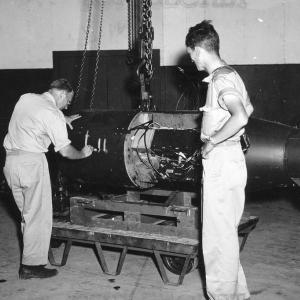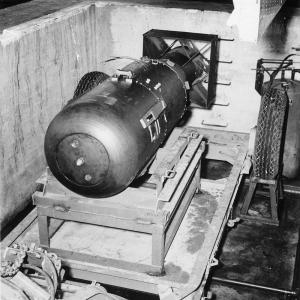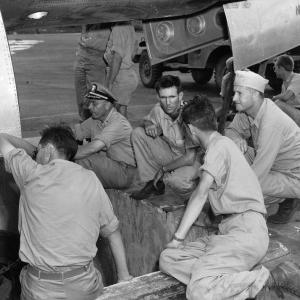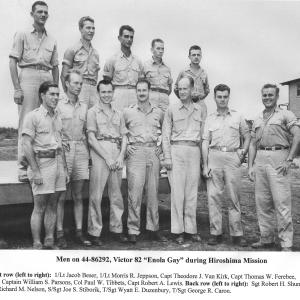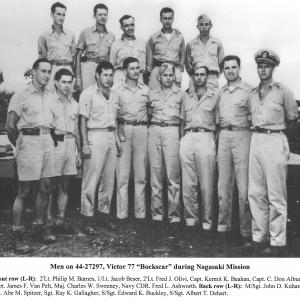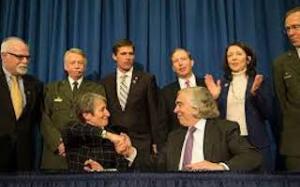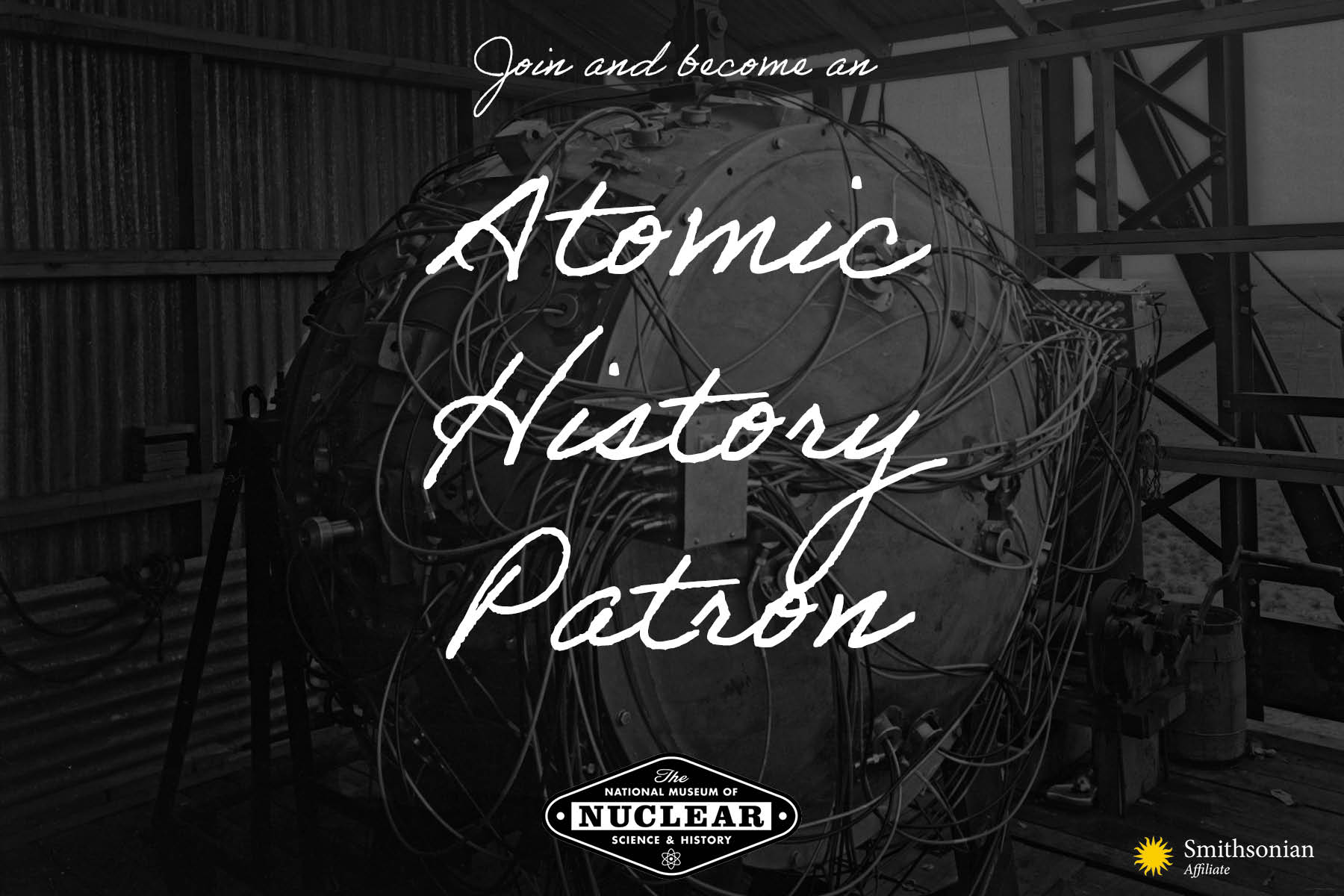All of the B-29s involved in the bombings of Hiroshima and Nagasaki and "pumpkin bomb" training and combat missions at Wendover, UT and on Tinian were Project Silverplate B-29s. They had been specially modified to accomodate the size and weight of the atomic bombs. Crews were often rotated around during the missions. The term “pumpkin bomb” can apply to both the dummy concrete bombs used at Wendover for training, and to the high-explosive bombs dropped over Japan.
There are many incorrect lists online of the planes and crews that flew on the Hiroshima and Nagasaki bombing missions. This list has been thoroughly checked for accuracy by several 509th Composite Group experts and historians.
Hiroshima Mission Planes
Enola Gay. Strike plane carrying Little Boy.
The Great Artiste. Observation/instrument plane.
Necessary Evil. Camera plane.
Full House. Weather reconnaissance.
Jabit III. Weather reconnaissance.
Straight Flush. Weather reconnaissance.
Big Stink. Backup strike plane on Iwo Jima.
Enola Gay, Hiroshima Mission
Strike plane carrying Little Boy atomic bomb. A modified Crew B-9 flew the plane.
Col. Paul Tibbets. Pilot and aircraft commander.
Capt. Robert A. Lewis. Co-pilot and aircraft commander.
Major Thomas Ferebee. Bombardier.
Capt. Theodore "Dutch" Van Kirk. Navigator.
T/Sgt Wyatt E. Duzenbury. Flight engineer.
1LT Jacob Beser. Radar countermeasures. Only person to fly on the strike plane on both bombing missions.
T/Sgt George "Bob" R. Caron. Tail gunner.
Sgt. Joseph S. Stiborik. Radar operator.
Sgt. Robert H. Shumard. Assistant flight engineer.
Pfc. Richard H. Nelson. VHF radio operator.
Capt. William "Deak" Parsons. Weaponeer and mission commander.
2LT Morris R. Jeppson. Assistant weaponeer.
The Great Artiste, Hiroshima Mission
Observation/instrument plane. Regular crew (Crew C-15) flew the plane, with the exception of co-pilot 2LT Frederick J. Olivi. Olivi did not fly on this mission because he was "pre-empted because they had to have some scientific observers on board," according to an interview with Olivi.
Major Charles W. Sweeney. Aircraft commander.
1LT Charles Donald Albury. Pilot.
Capt. James Van Pelt. Navigator.
Cpt. Kermit K. Beahan. Bombardier.
Cpl. Abe Spitzer. Radio operator.
M/Sgt John D. Kuharek. Flight engineer.
S/Sgt Ray Gallagher. Gunner, assistant flight engineer.
S/Sgt Edward Buckley. Radar operator.
Sgt. Albert Dehart. Tail gunner.
Luis Alvarez. Scientific observer.
Harold Agnew. Scientific observer.
Lawrence H. Johnston. Scientific observer. He was the only person to witness the Trinity test and the bombings of Hiroshima and Nagasaki.
Necessary Evil, Hiroshima Mission
Camera plane. Crew B-10 (regularly assigned to Up An' Atom) flew the plane.
Capt. George W. Marquardt. Aircraft commander.
Lt. James W. Anderson. Co-pilot.
Lt. Russell Gackenbach. Navigator.
Capt. James W. Strudwick. Bombardier.
T/Sgt James R. Corliss. Flight Engineer.
Sgt. Warren L. Coble. Radio operator.
Sgt. Joseph M. DiJulio. Radio operator.
Sgt. Melvin H. Bierman. Tail gunner.
Sgt. Anthony D. Capua, Jr. Assistant engineer/scanner.
Bernard Waldman. Camera operator.
Full House, Hiroshima Mission
Weather reconnaissance over Nagasaki. Regular crew (Crew A-1) flew the plane.
Capt. Ralph R. Taylor, Jr. Aircraft commander.
2LT Raymond P. Biel. Co-pilot.
1LT Fred A. Hoey. Navigator.
1LT Michael Angelich. Bombardier.
M/Sgt Frank M. Briese. Flight engineer.
S/Sgt Theodore M. Slife. Radio operator.
Cpl. Nathaniel T. R. Burgwyn. Radar operator.
T/Sgt Robert J. Valley. Tail gunner.
Cpl. Richard B. Anselme. Assistant engineer/scanner.
Jabit III, Hiroshima Mission
Weather reconnaissance over Kokura. Regular crew (Crew B-6) flew plane.
Capt. John A. Wilson. Aircraft commander.
2LT Ellsworth T. Carrington. Co-pilot.
2LT James S. Duva. Navigator.
2LT Paul W. Gruning. Bombardier.
M/Sgt James W. Davis. Flight engineer.
S/Sgt Glen H. Floweree. Radio operator.
Sgt. Vernon J. Rowley. Radar operator.
Cpl. Chester A. Rogalski. Tail gunner.
Cpl. Donald L. Rowe. Assistant engineer/scanner.
Straight Flush, Hiroshima Mission
Weather reconnaissance over Hiroshima. Regular crew (Crew C-11) flew plane.
Capt. Claude Eatherly. Aircraft commander.
2LT Ira C. Weatherly. Pilot.
Cpt. Francis D. Thornhill. Navigator.
2LT Frank K. Wey, Jr. Bombardier.
2LT Eugene S. Grennan. Flight engineer.
S/Sgt Pasquale Baldasaro. Radio operator.
Sgt. Albert G. Barsumian. Radar operator.
Sgt. Gillen T. Nicely. Tail gunner.
Sgt. Jack Bivans. Assistant engineer/scanner.
Big Stink, Hiroshima Mission
Backup strike plane on Iwo Jima. Crew B-8 (reguarly assigned to Top Secret) flew the plane.
1LT Charles F. McKnight. Airplane commander.
2LT Jacob Y. Bontekoe. Co-pilot.
2LT Jack Widowsky. Navigator.
2LT Franklin H. MacGregor. Bombardier.
1LT George H. Cohen. Flight engineer.
Sgt. Lloyd J. Reeder. Radio operator.
T/Sgt William F. Orren. Radar operator.
Sgt. Roderick E. Legg. Tail gunner.
Cpl. Donald O. Cole. Assistant engineer/scanner.
Nagasaki Mission Planes
Bockscar. Strike plane carrying Fat Man.
The Great Artiste. Observation/instrument plane.
Big Stink. Camera plane.
Enola Gay. Weather reconnaissance.
Laggin' Dragon. Weather reconnaissance.
Full House. Backup strike plane on Iwo Jima.
Bockscar, Nagasaki Mission
Strike plane carrying Fat Man atomic bomb. A modified Crew C-15 (regularly assigned to The Great Artiste) flew the plane.
Major Charles W. Sweeney. Aircraft commander.
1LT Charles Donald Albury. Pilot.
2LT Frederick J. Olivi. Co-pilot.
Capt. James Van Pelt. Navigator.
Cpt. Kermit K. Beahan. Bombardier.
M/Sgt John D. Kuharek. Flight engineer.
Cpl. Abe Spitzer. Radio operator.
S/Sgt Edward Buckley. Radar operator.
Sgt. Albert Dehart. Tail gunner.
S/Sgt Ray Gallagher. Assistant flight engineer/scanner.
1LT Jacob Beser. Radar countermeasures. Only person to fly on the strike plane on both bombing missions.
CDR Frederick Ashworth. Weaponeer.
LT Philip M. Barnes. Assistant weaponeer.
The Great Artiste, Nagasaki Mission
Observation/instrument plane. Crew C-13 (regularly assigned to Bockscar) flew the plane.
Cpt. Frederick C. Bock. Aircraft commander.
Lt. Hugh Ferguson. Co-pilot.
Lt. Leonard A. Godfrey. Navigator.
Lt. Charles Levy. Bombardier.
M/Sgt Roderick F. Arnold. Flight engineer.
Sgt. Ralph D. Belanger. Assistant flight engineer.
Sgt. Ralph D. Curry. Radio operator.
Sgt. William C. Barney. Radar operator.
Sgt. Robert J. Stock. Tail gunner.
S/Sgt Walter Goodman. Scientific observer.
Lawrence H. Johnston. Scientific observer. He was the only person to witness the Trinity test and the bombings of Hiroshima and Nagasaki.
William L. Laurence. New York Times reporter.
T/Sgt Jesse Kupferberg. Scientific observer.
Big Stink, Nagasaki Mission
Camera plane. Crew C-14 (regularly assigned to Necessary Evil) flew the plane.
Major James I. Hopkins, Jr. Aircraft Commander. (Capt. Norman Ray was the crew's regular aircraft commander, but he was ill and did not participate in the mission.)
2LT James E. Cantlon. Co-pilot.
2LT Stanley G. Steinke. Navigator.
2LT Myron Faryna. Bombardier.
M/Sgt George L. Brabenec. Flight engineer.
Sgt. Francis X. Dolan. Radio operator.
Cpl. Richard F. Cannon. Radar operator.
Sgt. Martin G. Murray. Tail gunner.
Sgt. Thomas A. Bunting. Assistant engineer/scanner.
Cpl. Sidney J. Bellamy. Radar observer.
Leonard Cheshire. Scientific observer.
William Penney. Scientific observer.
Robert Serber was supposed to fly as a scientific observer and camera operator, but he forgot his parachute and was not allowed on the mission.
Enola Gay, Nagasaki Mission
Weather reconnaissance over Kokura. Crew B-10 (regularly assigned to Up An' Atom) flew the plane.
Capt. George W. Marquardt. Aircraft commander.
Lt. James W. Anderson. Co-pilot.
Lt. Russell Gackenbach. Navigator.
Capt. James W. Strudwick. Bombardier.
T/Sgt James R. Corliss. Flight Engineer.
Sgt. Warren L. Coble. Radio operator.
Sgt. Joseph M. DiJulio. Radio operator.
Sgt. Melvin H. Bierman. Tail gunner.
Sgt. Anthony D. Capua, Jr. Assistant engineer/scanner.
Laggin' Dragon, Nagasaki Mission
Weather Reconnaissance over Nagasaki. Crew B-8 (regularly assigned to Top Secret) flew the plane.
1LT Charles F. McKnight. Airplane commander.
2LT Jacob Y. Bontekoe. Co-pilot.
2LT Jack Widowsky. Navigator.
2LT Franklin H. MacGregor. Bombardier.
1LT George H. Cohen. Flight engineer.
Sgt. Lloyd J. Reeder. Radio operator.
T/Sgt William F. Orren. Radar operator.
Sgt. Roderick E. Legg. Tail gunner.
Cpl. Donald O. Cole. Assistant engineer/scanner.
Full House, Nagasaki Mission
Backup strike plane on Iwo Jima. Regular crew (Crew A-1) flew plane.
Capt. Ralph R. Taylor, Jr. Aircraft commander.
2LT Raymond P. Biel. Co-pilot.
1LT Fred A. Hoey. Navigator.
1LT Michael Angelich. Bombardier.
M/Sgt Frank M. Briese. Flight engineer.
S/Sgt Theodore M. Slife. Radio operator.
Cpl. Nathaniel T. R. Burgwyn. Radar operator.
T/Sgt Robert J. Valley. Tail gunner.
Cpl. Richard B. Anselme. Assistant engineer/scanner.
*Note: Full House flew as the backup strike aircraft during the Nagasaki mission, but landed and remained at Iwo Jima when Bockscar was able to complete the mission.
Regularly Assigned Plane Crews
The crews for Straight Flush, Full House, and Jabit III flew in their regularly assigned planes for the atomic bombing missions, but the crews regularly assigned to the Enola Gay, Bockscar, The Great Artiste, Necessary Evil, Laggin' Dragon, and Up an' Atom flew in different planes for the missions.
Crew A-3 (assigned to Next Objective), Crew A-4 (Strange Cargo), Crew B-7 (Some Punkins) flew on several combat missions over Japan from Tinian, but did not fly in the Hiroshima or Nagasaki atomic bombing missions. Crew C-12 (Luke the Spook) participated in training missions.
Big Stink, Regular Crew (Crew A-5)
Crew A-5 flew three combat missions. They returned to Wendover, UT, in the B-29 Luke the Spook, on August 9, 1945, in case they were needed to transport another Fat Man plutonium core. Big Stink was flown by Crew B-8 on the Hiroshima bombing mission and Crew C-14 on the Nagasaki bombing mission.
Lt. Col. Thomas J. Classen. Aircraft commander.
2LT William M. Rowe, Jr. Co-pilot.
Capt. William E. Wright. Navigator.
Capt. Bobby J. Chapman. Bombardier.
1LT Floyd W. Kemner. Flight engineer.
T/Sgt Omar C. Strickland. Radio operator.
Cpl. George A. Weller. Radar operator.
S/Sgt Alfred A. Lewandowski. Tail gunner.
Cpl. Lee E. Caylor. Assistant engineer/scanner.
Ground crew: T/Sgt Claude E. McLenon, Cpl. Roy K. Balliet, Cpl. Donald E. Piehl, Cpl. Calvin B. Popwell, and Pfc. Hinginio A. Baca.
Bockscar, Regular Crew (Crew C-13)
Crew C-13 flew five combat missions, including the Nagasaki bombing mission in The Great Artiste. Bockscar was flown by a modified Crew C-15 on the Nagasaki mission.
Cpt. Frederick C. Bock. Aircraft commander.
Lt. Hugh Ferguson. Co-pilot.
Lt. Leonard A. Godfrey. Navigator.
Lt. Charles Levy. Bombardier.
M/Sgt Roderick F. Arnold. Flight engineer.
Sgt. Ralph D. Curry. Radio operator.
Sgt. William C. Barney. Radar operator.
Sgt. Robert J. Stock. Tail gunner.
Sgt. Ralph D. Belanger. Assistant flight engineer.
Ground crew: S/Sgt Frederick D. Clayton, Sgt. Robert L. McNamee, Sgt. John L. Willoughby, Cpl. Robert M. Haider, and Pfc. Rudolph H. Gerken.
Enola Gay, Regular Crew (Crew B-9)
Crew B-9 flew five combat missions, including the Hiroshima bombing mission. Enola Gay was flown by a modified Crew B-9 for the Hiroshima mission and Crew B-10 for the Nagasaki mission.
Capt. Robert A. Lewis. Aircraft commander.
2LT Richard McNamara. Pilot.
2LT Harold J. Rider. Navigator.
1LT Stewart W. Williams. Bombardier.
T/Sgt Wyatt E. Duzenbury. Flight engineer.
Pfc. Richard H. Nelson. VHF radio operator.
Sgt. Joseph S. Stiborik. Radar operator.
T/Sgt George "Bob" R. Caron. Tail gunner.
Sgt. Robert H. Shumard. Assistant flight engineer.
Ground crew: Sgt. Steve C. Lizak, Sgt. Leonard W. Markley, Cpl. Jean S. Cooper, Cpl. Winfield C. Kinkade, Pfc. John E. Jackson, Pfc. John J. Lesniewski, and Pfc. Harold R. Olson.
Full House, Regular Crew (A-1)
Crew A-1 flew six combat missions, including the Hiroshima and Nagasaki bombing missions in which they flew in Full House.
Capt. Ralph R. Taylor, Jr. Aircraft commander.
2LT Raymond P. Biel. Co-pilot.
1LT Fred A. Hoey. Navigator.
1LT Michael Angelich. Bombardier.
M/Sgt Frank M. Briese. Flight engineer.
S/Sgt Theodore M. Slife. Radio operator.
Cpl. Nathaniel T. R. Burgwyn. Radar operator.
T/Sgt Robert J. Valley. Tail gunner.
Cpl. Richard B. Anselme. Assistant engineer/scanner.
Ground crew: S/Sgt Glen Mahugh, Cpl. Chester A. Hammond, Sgt. Steve J. Kinosh, Jr., Cpl. William B. Reedy, Cpl. Donald D. Fockler, and Pfc. Mario A. Litterio.
Jabit III, Regular Crew (Crew B-6)
Crew B-6 flew four combat missions, including the Hiroshima bombing mission in which they flew in Jabit III.
Capt. John A. Wilson. Aircraft commander.
2LT Ellsworth T. Carrington. Co-pilot.
2LT James S. Duva. Navigator.
2LT Paul W. Gruning. Bombardier.
M/Sgt James W. Davis. Flight engineer.
S/Sgt Glen H. Floweree. Radio operator.
Sgt. Vernon J. Rowley. Radar operator.
Cpl. Chester A. Rogalski. Tail gunner.
Cpl. Donald L. Rowe. Assistant engineer/scanner.
Ground crew: Sgt. Charles J. Baker, Pfc. Kenneth L. Baxter, Sgt. Pasquale Lazzarino, Cpl. William F. Jellick, and Cpl. George I. Schreffer.
Laggin' Dragon, Regular Crew (Crew A-2)
Crew A-2 did not fly any combat missions because of their late arrival on Tinian (August 2, 1945). Laggin' Dragon was flown by Crew B-8 on the Nagasaki bombing mission.
Capt. Edward M. Costello. Aircraft commander.
2LT Harry B. Davis. Pilot.
2LT Robert J. Petrolli. Co-pilot.
2LT John L. Downey. Bombardier.
2LT Thomas H. Brumagin. Flight engineer.
Sgt. David Purdon. Radio operator.
Cpl. James R. Bryant. Radar operator.
M/Sgt Carleton A. McEachern. Tail gunner.
Sgt. Maurice J. Clark. Assistant engineer/scanner.
Ground crew: M/Sgt John C. Hansen, S/Sgt Robert J. Dowling, Cpl. Robert E. Holse, Cpl. Robert R. Garn, Pfc. Fred D. Butler, Pfc. James McGlennon, and Pfc. Charles W. Rich.
Luke the Spook, Regular Crew (Crew C-12)
Crew C-14 did not fly any combat missions because of their late arrival on Tinian (August 2, 1945). After Luke the Spook was flown back to the US on August 9, Crew C-12 was assigned the B-29 Big Stink. Luke the Spook was given its name after its return to the US.
Capt. Herman S. Zahn. Aircraft commander.
2LT Gilbert B. Dickman. Pilot.
1LT Henry Deutsch. Navigator.
F/O Francis R. Ormond. Bombardier.
T/Sgt James K. Elder. Flight engineer.
S/Sgt Leander J. Baur. Radio operator.
Sgt. Gerald F. Clapso. Radar operator.
Sgt. Raymond E. Allen. Tail gunner.
Sgt. Neil R. Corey. Assistant engineer/scanner.
Ground crew: M/Sgt Elbert E. Owens, S/Sgt Carl W. Rein, Cpl. Gerald J. Corcoran, Sgt. Francis A. Pellegrino, and Cpl. Lavern A. Holmes.
Necessary Evil, Regular Crew (Crew C-14)
Crew C-14 flew five combat missions, including the bombing of Nagasaki in the B-29 Big Stink. Necessary Evil was flown by Crew B-10 on the Hiroshima bombing mission.
Capt. Norman Ray. Aircraft Commander.
2LT James E. Cantlon. Co-pilot.
2LT Stanley G. Steinke. Navigator.
2LT Myron Faryna. Bombardier.
M/Sgt George L. Brabenec. Flight engineer.
Sgt. Francis X. Dolan. Radio operator.
Cpl. Richard F. Cannon. Radar operator.
Sgt. Martin G. Murray. Tail gunner.
Sgt. Thomas A. Bunting. Assistant engineer/scanner.
Ground crew: Sgt. William E. Egger, Cpl. Richard E. Blouse, Cpl. Woitto T. Laine, Cpl. Paul C. Schafhauser, Pfc. Barton B. Crespin, Pfc. Edgar A. Poe, Jr., and Pfc. Troy B. Scott.
Next Objective, Regular Crew (Crew A-3)
Crew A-3 flew four combat missions.
Capt. Ralph N. Devore. Airplane commander.
2LT William J. Easton. Pilot.
2LT Franklin B. Wimer. Navigator.
2LT Leon Cooper. Bombardier.
2LT William T. Hulse. Flight engineer.
Sgt. Lee E. Palmert. Radio operator.
Sgt. Michael B. Bohon. Radar operator.
Cpl. Glenn S. Allison. Tail gunner.
Cpl. Clarence E. Britt. Assistant engineer/scanner.
Ground crew: T/Sgt Forrest C. Anderson, Sgt. Marion C. Fowler, Jr., Sgt. Mack Newsom, Cpl. James R. Womack, Pfc. Jerry Grubaugh, Jr., and Pfc. Charles E. Schwab.
Some Punkins, Regular Crew (Crew B-7)
Crew B-7 flew five combat missions.
Capt. James N. Price, Jr. Aircraft commander.
2LT Everist L. Bednorz. Pilot.
1LT William J. Collinson. Navigator.
1LT Thomas F. Costa. Bombardier.
M/Sgt James A. Adkins. Flight engineer.
S/Sgt Robert H. Byrd. Radio operator.
Cpl. Joe R. Brown. Radar operator.
Cpl. Clyde L. Bysom. Tail gunner.
Sgt. Frederick E. Brown. Assistant engineer/scanner.
Ground crew: S/Sgt Russell D. Carrigan, S/Sgt Raymond G. St. Myers, Cpl. William R. Compronio, Cpl. William R. Crotty, Cpl. Joe M. Madrid, Pfc. Edward M. Josefiak, and Pfc. Donald E. Miller.
Straight Flush, Regular Crew (Crew C-11)
Crew C-11 flew six combat missions, including the Hiroshima bombing mission in which they flew in Straight Flush.
Capt. Claude Eatherly. Aircraft commander.
2LT Ira C. Weatherly. Pilot.
Cpt. Francis D. Thornhill. Navigator.
2LT Frank K. Wey, Jr. Bombardier.
2LT Eugene S. Grennan. Flight engineer.
S/Sgt Pasquale Baldasaro. Radio operator.
Sgt. Albert G. Barsumian. Radar operator.
Sgt. Gillen T. Nicely. Tail gunner.
Sgt. Jack Bivans. Assistant engineer/scanner.
Ground crew: T/Sgt Donald D. Beaudette, Sgt. Howard A. Thompson, Cpl. Yive J. H. Ping, Cpl. William E. Smith, Cpl. Chester S. Chudy, Pfc. Harold E. Knisley, and Cpl. William J. Jacks.
Strange Cargo, Regular Crew (Crew A-4)
Crew A-4 flew four combat missions.
Capt. Joseph E. Westover. Aircraft commander.
2LT William J. Desmond. Pilot.
2LT John W. Dulin. Navigator.
2LT Louis B. Allen. Bombardier.
1LT Robert M. Donnell. Flight engineer.
S/Sgt James H. Doiron. Radio operator.
S/Sgt William J. Cotter. Radar operator.
S/Sgt Walter A. Spradlin. Tail gunner.
Sgt. Samuel R. Wheeler. Assistant engineer/scanner.
Ground crew: M/Sgt Robert E. Smithson, Sgt. Clyde R. Beecher, Sgt. Cleo E. Harter, Cpl. Filbert Reynolds, Cpl. Derward A. Stevens, Cpl. John H. Hubeny, Jr., and Pfc. Francis J. Merry.
The Great Artiste, Regular Crew (Crew C-15)
Crew C-15 flew five combat missions, including the Hiroshima mission in which they flew in The Great Artiste and the Nagasaki bombing mission in which they flew in the strike plane Bockscar.
1LT Charles Donald Albury. Aircraft commander.
2LT Frederick J. Olivi. Pilot.
Capt. James Van Pelt. Navigator.
Cpt. Kermit K. Beahan. Bombardier.
Cpl. Abe Spitzer. Radio operator.
M/Sgt John D. Kuharek. Flight engineer.
S/Sgt Ray Gallagher. Gunner, assistant flight engineer.
S/Sgt Edward Buckley. Radar operator.
Sgt. Albert Dehart. Tail gunner.
Ground crew: Cpl. Claude C. Gilliam, Cpl. Allan L. Moore, Cpl. James J. Reilly, Pfc. Theron L. Blaisdell, and Pfc. Robert E. Davenport.
Top Secret, Regular Crew (Crew B-8)
Crew B-8 flew six combat missions, including the Hiroshima bombing mission in which they flew in Big Stink and the Nagasaki bombing mission in which they flew in Laggin' Dragon.
1LT Charles F. McKnight. Airplane commander.
2LT Jacob Y. Bontekoe. Co-pilot.
2LT Jack Widowsky. Navigator.
2LT Franklin H. MacGregor. Bombardier.
1LT George H. Cohen. Flight engineer.
Sgt. Lloyd J. Reeder. Radio operator.
T/Sgt William F. Orren. Radar operator.
Cpl. Donald O. Cole. Assistant engineer/scanner.
Ground crew: T/Sgt Arnold E. Sleipnes, Sgt. Carmine A. Genova, Cpl. Chester J. Krajewski, Cpl. Oscar J. Thigpen, Pfc. Francis J. Schramke, and Pfc. Frank E. Sutton.
Up An' Atom, Regular Crew (Crew B-10)
Crew B-10 flew four combat missions, including the Hiroshima bombing mission in which they flew in Necessary Evil and the Nagasaki bombing mission in which they flew in Enola Gay.
Capt. George W. Marquardt. Aircraft commander.
Lt. James W. Anderson. Co-pilot.
Lt. Russell Gackenbach. Navigator.
Capt. James W. Strudwick. Bombardier.
T/Sgt James R. Corliss. Flight Engineer.
Sgt. Warren L. Coble. Radio operator.
Sgt. Joseph M. DiJulio. Radio operator.
Sgt. Melvin H. Bierman. Tail gunner.
Sgt. Anthony D. Capua, Jr. Assistant engineer/scanner.
Ground crew: T/Sgt Joseph I. Gulick, Sgt. George J. Brown, Sgt. Matthew W. Huddleston, Cpl. Frank W. Berzinis, Pfc. Aram E. Bezdegian, and Pfc. Carl C. Mason.
Gallery
Interview with Atomic Bomb Crew
- Richard H. Campbell. The Silverplate Bombers. 2005.
- Paul W. Tibbets. Return of the Enola Gay. 1998.
- Robert and Amelia Krauss. The 509th Remembered – A History of the 509th Composite Group as Told by the Veterans that Dropped the Atomic Bombs on Japan. 2009.
- Richard Rhodes, "Tongues of Fire" in The Making of the Atomic Bomb.
 National Museum of Nuclear Science & History
National Museum of Nuclear Science & History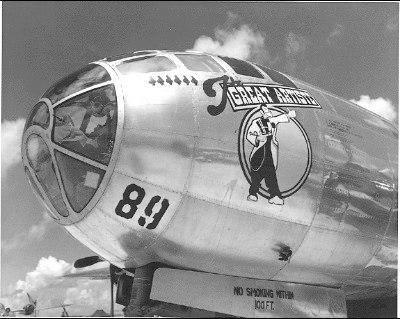
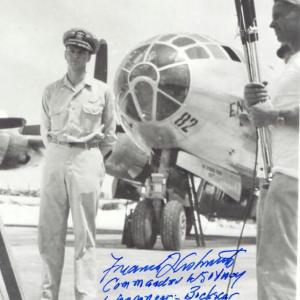
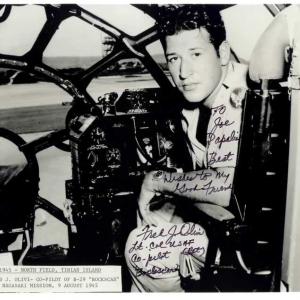
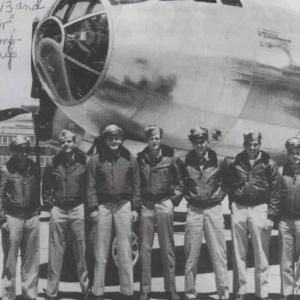
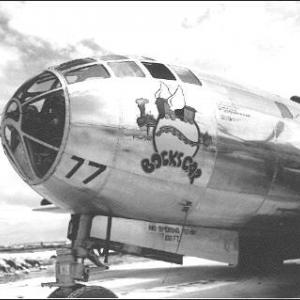
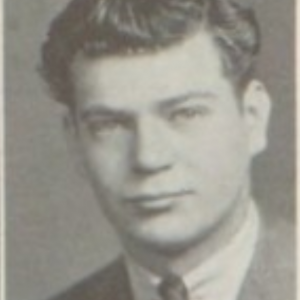
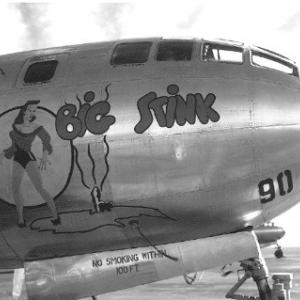
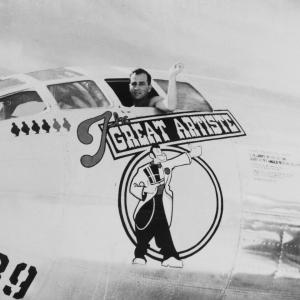
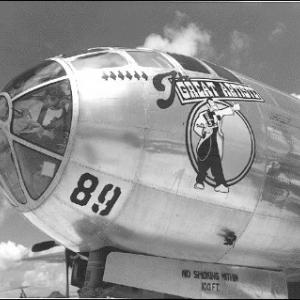
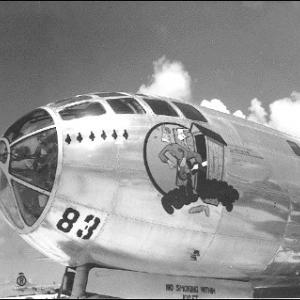
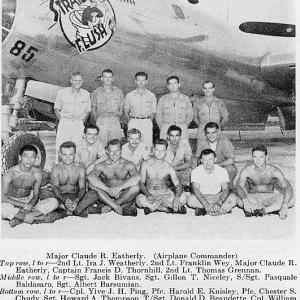
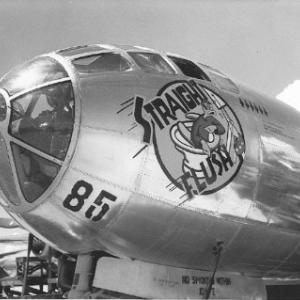
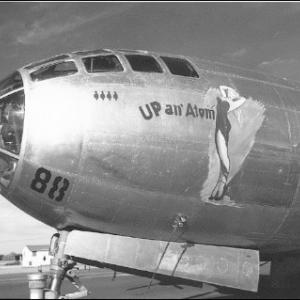
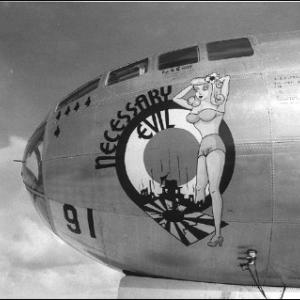

.jpg)
